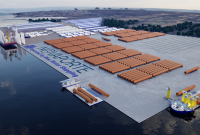Support strong Canadian climate journalism for 2025
Federal funding for a pioneering offshore wind power grid study in the Canadian Maritimes should help draw big-hitting developers to the region’s first project auction next year. But commercialization of the market remains on the far horizon, says a leading industry analyst.
Ottawa earlier this week awarded $6 million to Net Zero Atlantic, a low-carbon research and development hub in Nova Scotia, for the Atlantic Canada Offshore Wind Integration and Transmission Study, which aims to show how future offshore wind farms could export power to the onshore electricity network.
"While this government support for offshore wind transmission studies is a good step, there is a really long road ahead for Canada's offshore wind industry," Atin Jain, wind analyst for Bloomberg New Energy Finance (BNEF), told Canada's National Observer.
"Over the next year, the government must demonstrate long-term political and financial commitment to offshore wind to attract investors. A clear, predictable regulatory regime with streamlined permitting processes is crucial.
"Developers need certainty regarding environmental approvals and leasing procedures before committing billions of dollars of capital in a nascent sector," said Jain. To make projects economically viable, Canada must offer incentives such as tax credits, renewable energy certificates, feed-in tariffs, or so-called contracts for difference, frameworks previously used in other countries to subsidize early offshore wind projects, he noted.
The offshore grid study will investigate how power from Atlantic Canada’s offshore wind resources in the future can be used to decarbonize the regional electricity network by exporting "made-in-Canada renewable electricity and clean hydrogen" to international markets, the government statement on funding to Net Zero Atlantic said.
Sven Schlotzsky, Net Zero Atlantic's director of research, told Canada's National Observer the grid study will identify potential paths for seabed powerlines to export offshore wind to a range of Atlantic coastal markets. By establishing this ahead of next year’s auction, Atlantic Canada would have “greater ability to attract both domestic and foreign investment in offshore wind development," he said.
Nova Scotia was the first Canadian province to announce plans to develop its offshore wind resource at a scale to deliver power to utilities, starting with a five-gigawatts auction, where developers will be able to bid for maritime acreage on which to build wind farms.
The Atlantic Economic Council calculated in a recent report that offshore wind could become a market worth over $7 billion by 2030 in the Canadian Maritime provinces, generating a first wave of 5,000 jobs and delivering benefits to the regional economy.
“In the Atlantic, and in fact, across Canada, clean energy is presenting an unparalleled opportunity to deliver affordable and reliable energy while seizing enormous economic opportunities for Canadian workers," said Jonathan Wilkinson, Canada's Minister for Energy and Natural Resources, in a statement.
"A clean grid will underpin economic competitiveness and prosperity moving forward, and Net Zero Atlantic is a great example of the work underway to get there."
The Net Zero Atlantic study would help create opportunities for offshore development in the Atlantic region, said Natural Resources Canada spokesperson Bruce Blackie, in response to Canada's National Observer. He noted that it was further supported by Bill C-49, federal legislation designed to rework the petroleum regulatory scheme to include offshore renewable energy projects in Newfoundland and Labrador and Nova Scotia.
Nova Scotia’s offshore wind ambitions have been slower to develop than many originally foresaw. Despite high wind speeds averaging 11 to 13 metres per second (40-47 km/h) and a ready-to-diversify oil and maritime construction and supply chain, low industrial and residential power demand has thwarted the province’s wind development plans.
However, the rise of green hydrogen in recent years has sparked fresh interest in offshore wind for its ability to provide a steady, baseload power supply ideal for running electrolyzers used in hydrogen generation.
Still, offshore wind remains an expensive option for hydrogen production compared to the cost of power from onshore wind plants. This has led some industry players to explore how Atlantic Canadian offshore wind power could be channeled down to markets in the U.S. Northeast, including New York City — along much the same route as fossil gas has flowed since 1999 via the Maritimes and Northeast Pipeline between Nova Scotia and the state of Maine.
"Canada has extensive coastlines and high resource potential for offshore wind, but ensuring these factors [regulatory regime, permitting, environmental approval processes] are in place will be vital to generating interest from global and domestic developers," said BNEF's Jain.
While $6 million of the funding to Net Zero Atlantic will go toward the grid study, a further $3.25 million will be dedicated to technologies associated with fishing vessels and ferry fleets, agriculture, carbon capture, hydrogen and energy storage.
Tony Rushton, Nova Scotia's Minister of Housing, Infrastructure and Communities, said: “At the heart of Net Zero Atlantic’s initiatives lies a commitment to innovation and sustainability. By investing in cutting-edge research and fostering the development of new clean technologies, we’re paving the way for Atlantic Canada to achieve its net-zero targets while cultivating sustainable regional economic opportunities.
Developers have been slow to declare their interest in Nova Scotia's upcoming offshore wind auction, currently slated for 2025. Only Nova East, a special purpose company set up by Ireland's DP Energy and Monaco-headquartered SBM Offshore to build a 400MW floating wind project, has so far put its head above the parapet.
But Elisa Obermann, CEO of Marine Renewables Canada (MRC), an industry group, said she expected "most MRC members" - which include international developers such as France's EDF Renewables, Ireland's Simply Blue, and the UK's Reventus, as well as Canada's Northland Power and Everwind Fuels - to express interest in bidding in the leasing round.





Comments